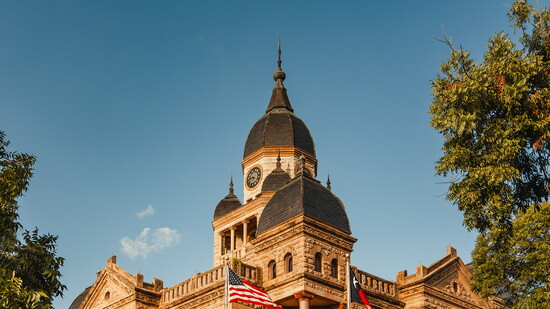At the heart of Denton’s downtown square stands a building that is part museum, part monument, and entirely a legacy. The Denton County Courthouse-on-the-Square, built in 1896, has become one of the most indelible symbols of the city’s past, serving as both centerpiece and storyteller for generations.
Denton’s earliest courthouses were modest affairs. The first was a simple two-story wooden structure on the north side of the square. It burned in 1875, taking precious county records with it. It was replaced by a brick courthouse at the center of the square, but lightning damage and deterioration led to its demolition in 1894. The following year, county commissioners authorized a new, grander courthouse with a mix of Romanesque Revival and Second Empire styles. Celebrated Texas architect W. C. Dodson was brought on to design it.
The cornerstone was laid in 1896, and the building was dedicated in 1897. From the start, the courthouse displayed an ambitious mix of materials: local limestone, pink granite piped in from Austin, red sandstone from Pecos, and tan sandstone from Mineral Wells.
Over the years, the courthouse has witnessed everything from local trials to presidential politics. During Dwight D. Eisenhower’s 1952 presidential campaign, he personally delivered a speech to an estimated 15,000 people on the courthouse lawn.
By 1978, many county operations had already moved to newer facilities, and part of the old building became home to the county’s historical museum. Restoration efforts began in earnest in the 1980s and 1990s, culminating in a full rededication in 2004. Thanks to the Texas Historic Courthouse Preservation Program and local dedication, the building was returned to its original glory using Dodson’s blueprints, while updating mechanical systems, safety codes, and venue uses.
Today, the courthouse is home to the Courthouse-on-the-Square Museum, managed by the Denton County Office of History & Culture. Inside, you’ll find exhibits that chronicle the rich tapestry of Denton County history, including local artifacts, military collections, folk art, and rotating special exhibits. The museum is more than just a collection of objects. It’s an invitation to step into the lives of the people who built and shaped Denton County. Whether you are an out-of-town visitor or a lifelong resident, you’ll find yourself educated and entertained as you explore the exhibits and archives.
But, the courthouse is more than just exhibit space. The surrounding lawn has become one of Denton’s favorite gathering places. It's a perfect spot for picnics, first dates, and summer concerts under the stars. From community festivals to live music nights, the courthouse square serves as the heartbeat of downtown life.
In the southeast corner of its grounds lies the grave of John B. Denton, the preacher, lawyer, and soldier for whom both the city and county are named. His headstone bears the engraving, “John B. Denton. Killed in the Village Creek Indian fight May 24, 1841. Named for the preacher, lawyer, soldier of that name.”
As the November chill rolls in and holiday lights brighten the square, the courthouse wears a different kind of crown — a beacon of history holding on to the stories that built our city. It is, in a very real sense, Denton’s own time machine: grounded in stone, reaching across generations.
Did You Know?
- Architectural Treasure: Designed by celebrated Texas architect W. C. Dodson, the courthouse combines Romanesque Revival and Second Empire styles.
- Presidential Visit: Dwight D. Eisenhower addressed 15,000 people on the courthouse lawn during his 1952 campaign.
- Community Hub: The lawn is home to concerts, festivals, and Denton traditions like Twilight Tunes.
- Namesake Resting Place: John B. Denton, the county’s namesake, is buried on the southeast corner of the courthouse grounds.
The lawn is home to concerts, festivals, and Denton traditions like Twilight Tunes.
